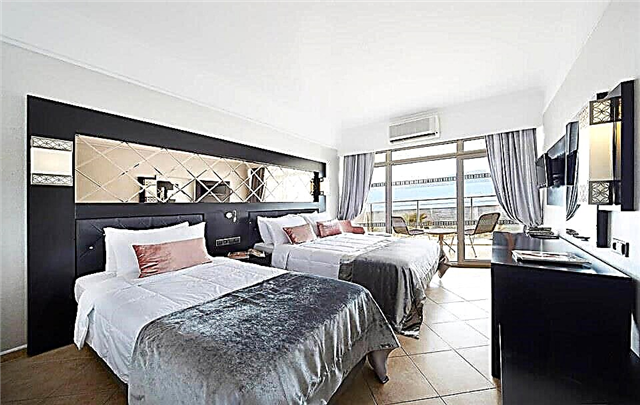Address: France, Paris, 4th arrondissement, rue Faubourg Saint-Honoré, 55
Start of construction: 1718 year
Completion of construction: 1722 year
Architect: Armand-Claude Mollet
Coordinates: 48 ° 52′13 ″ N 2 ° 19′0 ″ E
Content:
Short description
One of the main and most interesting, from an architectural point of view, buildings in all of France is located in Paris. True, its description is rarely found in guidebooks for this amazing and beautiful country.
Not everyone knows that the symbol of the supreme power of France (!) Is the magnificent and luxurious Elysee Palace in Paris. The palace is separated from the world-famous Champs Elysees by a dense living green fence, but from the curious crowd walking on a busy street called Faubourg Saint-Honoré, the building, built in the classical style, is literally protected by a powerful fortress wall.

A bird's eye view of the Elysee Palace
To the great regret of tourists, however, as well as the native Parisians, The Elysee Palace in Paris is almost always closed to the public... Only a lucky few who arrived in the capital of France in September manage to inspect its magnificent halls, unique architecture, garden and courtyards.
It is in the first month of autumn, on one of the days off, that the main symbol of the country opens its doors to everyone. Of course, there is nothing surprising in this arrangement, because this building is considered the official residence of the President of France.

View of the Elysee Palace from the rue Faubourg-Saint-Honoré
From the very beginning of the 19th century, the most important events took place within the walls of the Elysee Palace, documents were signed that influenced the further development of the country. To some extent, this significance played with the building, which is considered a model for modern architects, a cruel joke: it will forever remain in the shadows ... In the shadow of the brilliant and luxurious Versailles, Louvre, Notre Dame Cathedral and the Eiffel Tower. The Elysee Palace in Paris, even with all the desire, cannot be called a "visiting card" of the city.

The main gate of the palace
True, in this huge building with a luxurious interior, the Ministerial Council of France regularly meets, and on July 14 (Bastille Day and the Day of the French Republic) a rich reception for dignitaries is held in its garden. On the main public holiday, the sky above the palace flashes with thousands of multi-colored lights, which are visible to everyone walking along the Champs Elysees. By the way, the main building of the country got its name from the name of the Champs Elysees, not far from which it was built by the architect Armand-Claude Mollet. The history of the construction of the Parisian palace and the political events that took place in it undoubtedly deserve special attention.

Inner courtyard of the palace
Elysee Palace in Paris: construction and a short excursion into history
In 1718, the territory on which the Elysee Palace rises was acquired by the famous Count d'Evre... It is worth paying attention to the fact that the seller of this land plot was Armand-Claude Mollet, who at that time was considered by many to be the most talented and one of the best architects in France.
By the way, Mollet was the nephew of André Le Nôtre himself, who amazed Parisians and the whole Old World with his work on the park of the luxurious Palace of Versailles, the Champs Elysees and the garden of the famous Tuileries Palace.

Palace windows overlooking the courtyard
The deal, in which the land near the Champs Elysees became the property of the Comte d'Evre, provided that the seller would be engaged in the development of the plan and construction of the residence. As mentioned above, the nephew of André Le Nôtre, Armand-Claude Mollet, was selling this expensive plot near the Champs Elysees. Immediately after the sale of the territory near the suburb of Saint-Honoré, the first stone was laid in the construction of the residence of the Comte d'Evre.

Palace and courtyard view
The customer was delighted with the work of Mollet, who in just 4 years managed not only to develop a plan, to rebuild a magnificent palace, but also to lay out a magnificent French garden near it, fenced off from the Champs Elysees only by a hedge. Running a little ahead, it is worth noting that, despite numerous reconstructions and reconstructions, the main idea of the architect and the position of the palace have not been changed.

View of the Elysee Palace from the park
In his stately residence, the influential Count d'Evre lived until the end of his days. According to evidence preserved in some documents dating back to that era, a high-ranking official who was part of the upper strata of society could not leave the palace built by Le Nôtre's nephew for a long time.
After the death of the count, the residence, built in a fashionable style at that time, was bought by the influential Madame de Pompadour, who went down in history as the mistress of King Louis XV of France. This woman worshiped luxury and wealth: by her order, the famous architect Lassurance almost completely remodeled the front and second floor of the palace. Moreover, new shady alleys, a "golden grotto" and numerous cascades have appeared in the regular French garden.

Park with a fountain
Madame de Pompadour lived in her new estate for a very short time; after her, Marshal of the great European country Joachim Murat became the owner of the Elysee Palace. He decided that the palace, built at the time by Mollet, should be restored to its original form: the front door and the Small Apartments of the building are being redesigned again.
It is worth noting that the architects Thibault and Vigny, who were hired by the great military leader, also contributed to the interior: an art gallery and a huge Grand Staircase appeared in the palace. By the way, in the room where the paintings of the greatest artists were located, the Council of Ministers of France is currently meeting.

The gate to the palace park from the Champs Elysees side
Joachim Murat loved the country in which he was born and which he defended from enemies: in 1808, he voluntarily and gratuitously transfers the Elysee Palace to the ownership of France... From that moment on, the architectural masterpiece, about which, alas, practically no information is found in tourist brochures and on the Internet, has never been privately owned.
During the reign of Napoleon I, King Louis XVIII and President of the Second French Republic Louis Napoleon Bonaparte, the Elysee Palace in Paris was rebuilt several times. The exterior and interior, which can only be enjoyed by high-ranking persons in our time, the building received in the period from 1853 to 1867.

Salon Pompadour
Only in 1873, when the World Exhibition was held in a luxurious building, the Festive Hall was built. Naturally, over time, telephones, electricity, fully centralized heating and other modern benefits of civilization appeared in the building.
Elysee Palace in Paris: our time
As already mentioned above, to the greatest regret, the architectural masterpiece, created in just 4 years by Armand-Claude Mollet, is inaccessible for visiting and inspection. The President of France receives important guests there with enviable regularity. At official receptions in a building bordering the famous Champs Elysees, only the most expensive and rare wines and exquisite dishes are served.

Presidential table
A traveler who is lucky enough to get to the Elysee Palace in Paris in early September should not rush and inspect all rooms available to guests.
The halls, chambers and offices of this building have seen a lot in their lifetime: it was here that the defeated Napoleon personally signed his abdication and it was here that all the most important events in the life of the country took place and are taking place since 1808.

Golden living room
By the way, in the underground bunker of the Elysee Palace there is a huge study called the Hall of Jupiter. From this premises, the President of France can issue an order to launch military missiles with nuclear warheads. With the help of three ultra-modern screens, the head of the country can constantly keep in touch with the Minister of Defense and the commander of the French Air Force.
Naturally, even at a time when the Elysee Palace briefly opens its gates to all comers, the security will not allow a single traveler into this office. However, even without the Hall of Jupiter, literally every room will shock the tourist with its luxury and splendor. In addition, do not forget that Marigny Street runs very close to the eastern wall.

Hall of celebrations
The famous writer Herzen lived here, who wrote "Letters from the Avenue Marigny", which sheds light on what happened in the country during the French Revolution. The revolution, which many modern historians call nothing other than the "uprising of the barbarians" ...











